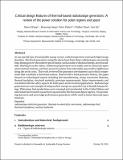| dc.contributor.author | Wang, Xiawa | |
| dc.contributor.author | Liang, Renrong | |
| dc.contributor.author | Fisher, Peter H | |
| dc.contributor.author | Chan, Walker R | |
| dc.contributor.author | Xu, Jun | |
| dc.date.accessioned | 2021-02-02T18:47:50Z | |
| dc.date.available | 2021-02-02T18:47:50Z | |
| dc.date.issued | 2020-03 | |
| dc.date.submitted | 2019-10 | |
| dc.identifier.issn | 1364-0321 | |
| dc.identifier.uri | https://hdl.handle.net/1721.1/129634 | |
| dc.description.abstract | As one special type of sustainable energy source, radioisotopes have extremely high energy densities. Electrical generators using the decay heat from these radioisotopes can provide long-lasting power when other types of energy, such as solar or chemical energy, are not available. Starting from the 1960s, radioisotope generators were safely used in numerous space and terrestrial missions, and have powered systems from interstellar spacecraft to lighthouses along the arctic coast. This work reviewed the generator development and critical components that constitute a functional system. Started with a brief generator history, the paper focused on technological aspects including fuel manufacturing, energy conversion elements, thermal insulation, structural materials, prototype measurements, future improvements, and concluded with the safety aspects for both space and terrestrial applications. Radioisotope generators are one example of using nuclear energy in a peaceful way to benefit human be-ings. Plutonium fuel productions were resumed and accelerated in the United States and americium fuel research was actively sponsored by the European Space Agency. It is promis-ing that more and more high performance generators will be used in future land and space missions. | en_US |
| dc.description.sponsorship | Army Research Office through the Institute for Soldier Nanotechnologies (Contracts W911NF-07-D0004, MAST 892730 and S3TEC DE-SC0001299) | en_US |
| dc.language.iso | en | |
| dc.publisher | Elsevier BV | en_US |
| dc.relation.isversionof | http://dx.doi.org/10.1016/j.rser.2019.109572 | en_US |
| dc.rights | Creative Commons Attribution-NonCommercial-NoDerivs License | en_US |
| dc.rights.uri | http://creativecommons.org/licenses/by-nc-nd/4.0/ | en_US |
| dc.source | Prof. Fisher via Barbara Williams | en_US |
| dc.title | Critical design features of thermal-based radioisotope generators: A review of the power solution for polar regions and space | en_US |
| dc.type | Article | en_US |
| dc.identifier.citation | Wang, Xiawa et al. "Critical design features of thermal-based radioisotope generators: A review of the power solution for polar regions and space." Renewable and Sustainable Energy Reviews 119 (March 2020): 109572 © 2019 Elsevier Ltd | en_US |
| dc.contributor.department | Massachusetts Institute of Technology. Department of Physics | en_US |
| dc.contributor.department | Massachusetts Institute of Technology. Institute for Soldier Nanotechnologies | en_US |
| dc.relation.journal | Renewable and Sustainable Energy Reviews | en_US |
| dc.eprint.version | Author's final manuscript | en_US |
| dc.type.uri | http://purl.org/eprint/type/JournalArticle | en_US |
| eprint.status | http://purl.org/eprint/status/PeerReviewed | en_US |
| dc.date.updated | 2021-01-27T16:37:08Z | |
| dspace.orderedauthors | Wang, X; Liang, R; Fisher, P; Chan, W; Xu, J | en_US |
| dspace.date.submission | 2021-01-27T16:37:13Z | |
| mit.journal.volume | 119 | en_US |
| mit.license | PUBLISHER_CC | |
| mit.metadata.status | Complete | |
